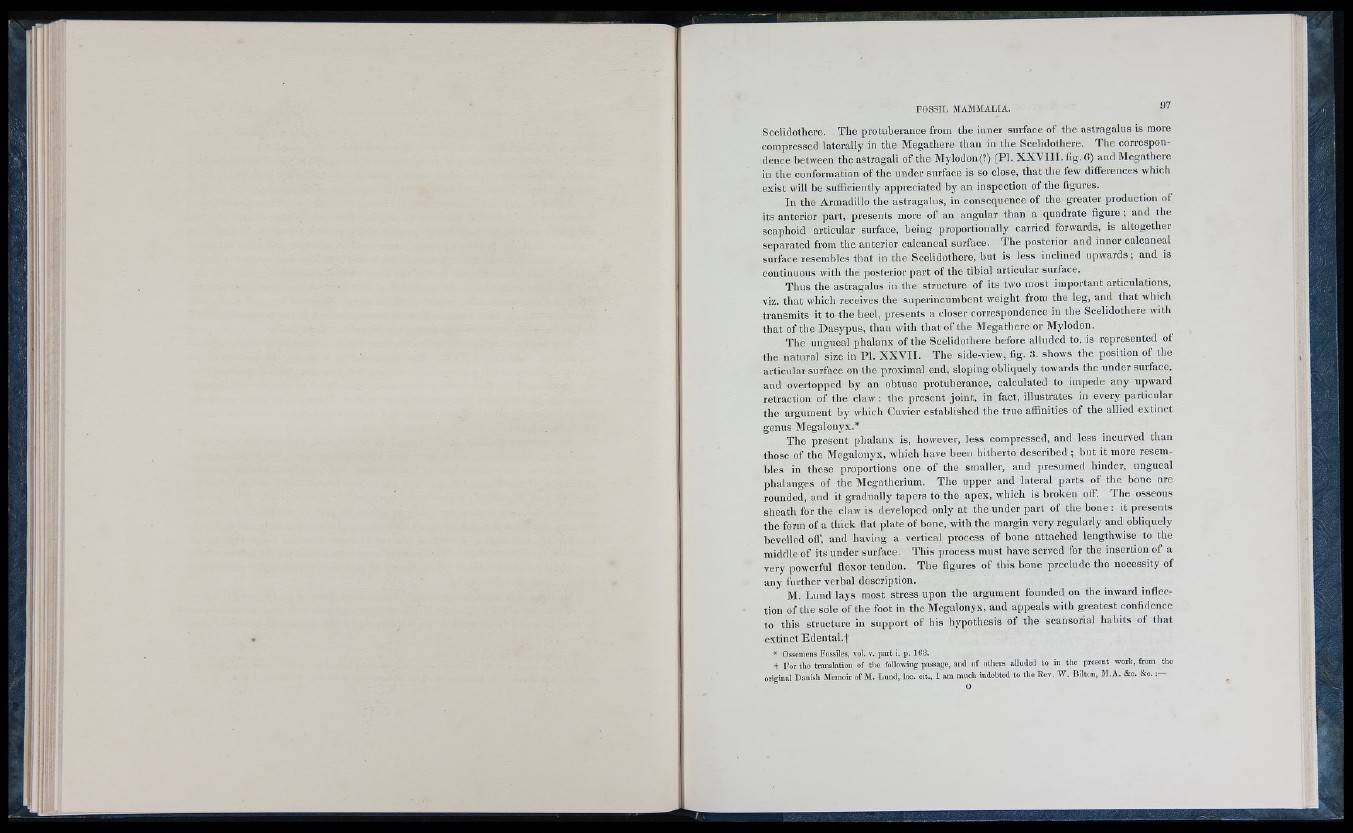
Scelidothere. The protuberance from the inner surface o f the astragalus is more
compressed laterally in the Megathere than in the Scelidothere. Th e correspondence
between the astragali o f the Mylodon(?) (PI. X X V I I I . fig. 0) and Megathere
in the conformation o f the under surface is so close, that the few differences which
ex ist will be sufficiently appreciated hy an inspection o f the figures.
In the Armadillo the astragalus, in consequence o f the greater production o f
its anterior part, presents more o f an angular than a quadrate figu r e ; and the
scaphoid articular surface, being proportionally carried forwards, is altogether
separated from the anterior calcaneal surface. Th e posterior and inner calcaneal
surface resembles that in the Scelidothere. hut is le ss inclined u pwa rds; and is
continuous with the posterior part o f the tibial articular surface.
Thus the astragalus in the structure o f its two most important articulations,
viz. that which receives the superincumbent weight from the leg, and that which
transmits it to the heel, presents a closer correspondence in the Scelidothere with
that o f the Da syp u s, than with that o f the Megathere or Mylodon.
The ungueal phalanx o f the Scelidothere before alluded to, is represented o f
the natural size in PI. X X V I I . The side-view, fig. 3. shows the position o f the
articular surface on the proximal end, sloping obliquely towards the under surface,
and overtopped by an obtuse protuberance, calculated to impede any upward
retraction o f the claw : the present joint, in fact, illustrates in every particular
the argument hy which Cuvier established the true affinities o f the allied extinct
genus Megalonyx.*
The present phalanx is, however, le ss compressed, and le ss incurved than
those o f the Megalonyx, which have been hitherto described ; but it more resembles
in these proportions one o f the smaller, and presumed hinder, ungueal
phalanges of the Megatherium. The upper and lateral parts o f the bone are
rounded, and it gradually tapers to the apex, which is broken off. The osseous
sheath for the claw is developed only at the under part o f the bone : it presents
the form o f a thick fiat plate o f bone, with the margin very regularly and obliquely
bevelled off, and having a vertical process o f bone attached lengthwise to the
middle o f its under surface. This process must have served for the insertion o f a
very powerful flexor tendon. The figures o f this bone preclude the necessity o f
any further verbal description.
M. Lund la y s most stress upon the argument founded on the inward inflection
of the sole o f the foot in the Megalonyx, and appeals with greatest confidence
to this structure in support o f his hypothesis o f the scansorial habits o f that
extinct E d en ta l.t
* Ossemens Fossiles, vol. v. part i. p. 163.
t For tlio translation of tlie following passage, and of others alluded to in the present work, from the
original Danish Memoir of M . Lund, loc. cit., I am much indebted to the Rev. W . Bilton, M.A. &c. &c.